When I ask people why they’re not active on LinkedIn, I get the same responses repeatedly.
LinkedIn is boring and intimidating.
I don’t know what to say.
I tried LinkedIn for a few weeks and barely got any bite.
Nobody reaches out to ask about my services.
LinkedIn is for “serious people,” not for me.
You’re scared of being yourself on LinkedIn because you feel intimidated by all the CEOs and marketers showing up with success stories. So, you’ve concluded that LinkedIn is a professional networking space where everyone wears suits and speaks perfect English.
Wrong. LinkedIn is human first, and just like any social media, the people who win are those who show up authentically. They share valuable advice that readers can implement immediately, and they do it consistently.
Let’s be clear. There is no magic trick or checklist to a successful LinkedIn marketing strategy. But you’ll not find any social media platform that rewards content creators with as many leads and conversions as LinkedIn does.
Here are some interesting stats to motivate you:
In this guide, you’ll learn how to create an effective LinkedIn marketing strategy for lead gen purposes.
How to Create an Effective LinkedIn Marketing Strategy
1. Know Your Audience
The first questions to answer when creating your LinkedIn marketing strategy are:
- Who is my ideal customer?
- Who do I need to connect with to generate leads and conversions from LinkedIn?
- What type of content will attract the right audience?
This is an essential step, and you should take time to figure out your target audience. When I started on LinkedIn, I was connecting with everyone. The CEO of the furniture company in Alabama. The small business owner running a funeral home in Oklahoma. Even the interior designer in New York.
I didn’t know my target audience because I hadn’t defined what I did and for whom. When I got clarity on my ideal user, I updated my LinkedIn profile to reflect this messaging.
As an SEO content writer and strategist, my target audience is content marketing managers and heads of SEO departments at SaaS and tech companies. Additionally, I target clients in the United States because these companies have a high awareness of SEO and the spending power to pay my rates.
Who will hire you for the skills you provide? The deeper your specialty, the more clarity you will have about your audience.
2. Study LinkedIn Influencers & Businesses That Hit the Mark
I spent three months studying influential people on LinkedIn to see the type of content they created. I realized that you could segment LinkedIn into two user groups:
- LinkedIn users who share valuable content that makes them the authority on a subject. An example is Ross Simmonds, who has established himself as a top authority in the content distribution niche.
- LinkedIn users with over 10,000 followers who share stories that don’t tell you anything about their expertise. Lots of engagement but few leads.
Who is posting great content in your niche? Study them, take pointers, and use that information to build your strategy.
3. Optimize Your LinkedIn Profile
Profile Image
Do not underestimate the power of a picture. I know it’s a tired cliché, but a picture is worth a thousand words (or maybe a thousand leads). According to LinkedIn, adding images doubles the number of comments a post receives.
Personal brand images build awareness and establish a connection with your audience. Pictures have the power to attract, persuade, and sell.
I invest in brand photographs every year, and it’s worked wonders for how people perceive me as a professional who knows her stuff.
There’s no hard or fast rule to choosing a LinkedIn profile picture, but here are a few tips:
- Project confidence
- Look directly at the camera
- Use your face in your profile picture, not your company logo
- Use a high-resolution image
- Make sure you’re the only person in the frame
- Create a background photo that promotes your offering
Below is an excellent example of a background image and profile photo from Michael King, Founder of iPullRank.

Title/Headline
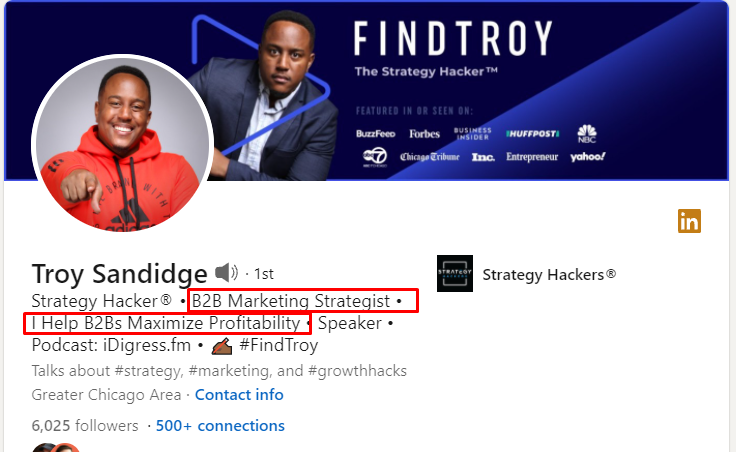
I have a simple formula for writing LinkedIn headlines: What you do + Who you do it for.
Using Troy’s Sandidge’s profile as an example, we have “Marketing Strategist + B2B.”
Your LinkedIn title flows from your knowledge of your target audience. Otherwise, you’ll be using the wrong keywords and attracting poor-quality leads.
Consider using a keyword that is findable. Think of words your target customer uses when searching for your services. Then, as you post consistently, you’ll effortlessly show up on LinkedIn results for your keyword. Here’s another example from Lily Ugbaja.
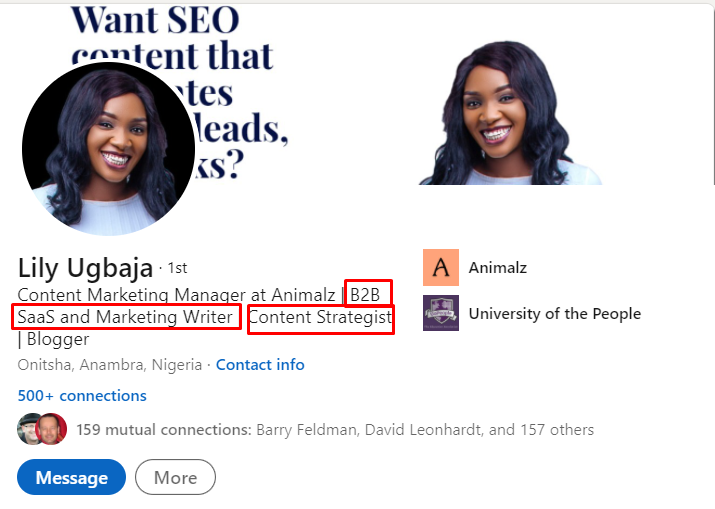
Bio
Your LinkedIn bio is perhaps one of the hardest things to write. It carries the weight of telling your ideal customer what you do, why they should work with you, and how to contact you.
The first line should grab attention and encourage the reader to click the see more button. Think of how you can communicate value in two sentences. My target audience wants content that ranks and I lead with this sentence.

When they click more, the story continues with the results I’ve driven for SaaS companies. First, the promise, followed by the fulfillment of that promise.
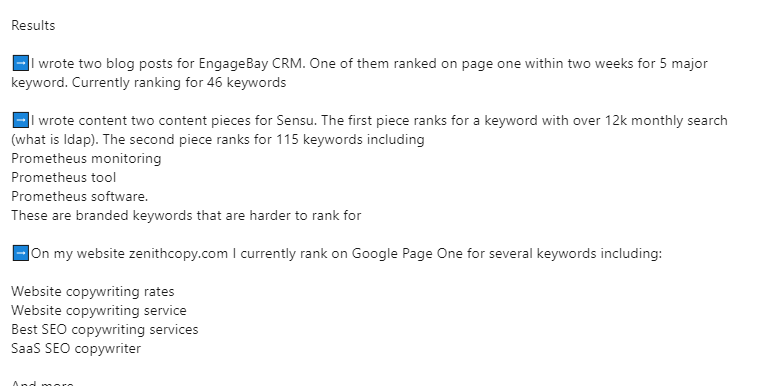
I follow up results with the specific services I offer. This is where I dial into the different problems I solve for my target audience.
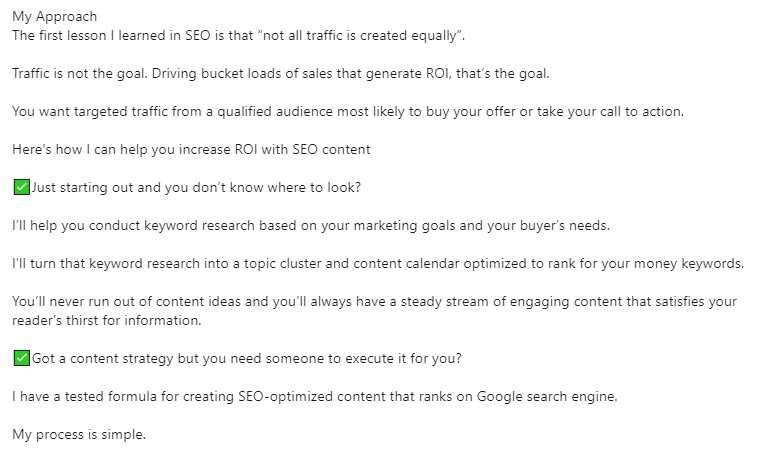
Finally, I conclude with a way to reach me. You could add your website, phone number, or email address as a CTA.

Fix your bio, and you’ll get more people reaching out via LinkedIn Messaging to inquire about your services. You can peep my full bio on LinkedIn.
Before settling on a final version, ask a few people from your target audience to read your bio and give feedback.
Featured Posts
Think of your LinkedIn profile like a funnel. It starts with your image, the title, bio, and continues with the Featured Posts. Use Featured Posts to share content about your expertise.
Here’s an example from conversion copywriter Diane Wiredu.
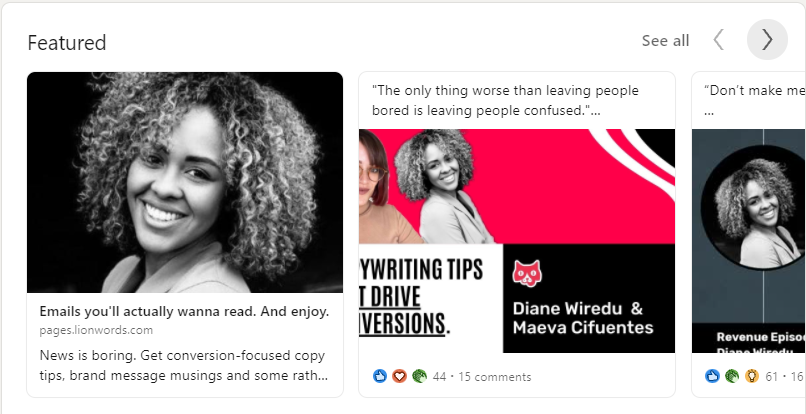
Recommendations
Recommendations are similar to testimonials you’d have on your website. It gives prospective clients an idea of what to expect when they work with you. My only trick for getting recommendations from clients is to do great work. Over-deliver and your clients will be happy to drop a recommendation when you ask.
For example, I can tell that Aaisha Joseph is an engaging speaker who is comfortable breaking down walls around diversity and inclusion.
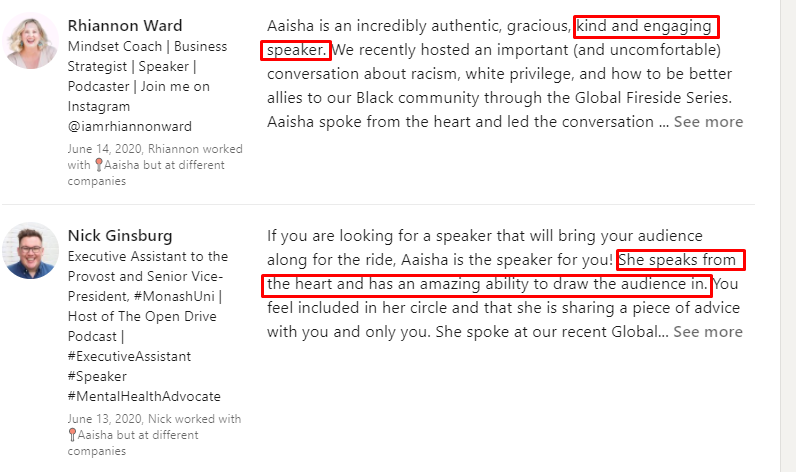
4. Connect with People You Want to Impress
Again, you need to know your target audience to connect with the right people. For example, when connecting with people on LinkedIn, I don’t just consider potential clients. I also think of peers who would find value in my content.
I’m a freelance content writer and strategist. So, I connect with:
- Potential customers — heads of content, SEO, and marketing departments.
- Peers — copywriters, in-house SEOs, marketers, and freelancers.
These are the two groups of people who understand my content when I write about SEO and content marketing. This means quality engagement that leads to new relationships and potential future referrals.
Finally, make sure you’re connecting with active users on LinkedIn, not LinkedIn users who only show up once in three months to check their messages. A LinkedIn Premium account shows this information.
5. Build Relationships
The most straightforward way to nurture relationships on LinkedIn is to comment on the posts of people you want to impress. I comment on any post I find helpful or engaging. I also try to leave comments on the posts of industry experts and connections that fall within my target audience.
Next, you can take it one step further by following Abby Reimer’s advice.
I nurture relationships by leading with learning. For example, I read many posts from industry thought leaders, and I often connect with the authors to let them know I liked their content. This has led to incredible opportunities and friendships I would never have made if I hadn’t reached out. Add value on LinkedIn by sharing what you learn and letting others know when you learn something from them.
6. Create a LinkedIn Page for Your Business
We’ve been talking about setting up your personal LinkedIn profile because humans like to connect with other humans. However, I don’t think brand profiles get as much engagement as personal profiles. So, it’s essential to optimize your personal profile first before setting up your brand profile.
LinkedIn Pages provide a way for you to connect with your target audience, hire employees, and maximize your LinkedIn lead gen efforts.
Here’s a comprehensive guide that walks you through the process of creating a LinkedIn page.
7. Promote Your LinkedIn Page
You can promote your company page through:
LinkedIn Ads
Use targeted advertising to reach a wider audience on LinkedIn. LinkedIn offers over 200 targeting characteristics to target members by name, location, industry, job title, and more. Options for LinkedIn ads include:
- Text ads that appear on profile pages, notifications, search results, group pages, and the homepage
- Sponsored content to amplify your business posts to a larger audience
- Sponsored InMail to send personalized cold messages to LinkedIn members
Your Personal Profile
I’m a big fan of using your personal profile to promote your business page.
Your options include:
- Re-sharing content from your personal profile to your business page and vice versa
- Referencing and tagging your LinkedIn page in a relevant post
- Sharing progress with client work
This usually works when you have a decent following on LinkedIn who engage with your content. For example, Elizabeth Leiba has over 98,000 followers on her personal profile and over 20,000 followers on her LinkedIn page. She creates content about her company’s impact on diversity and inclusion training.
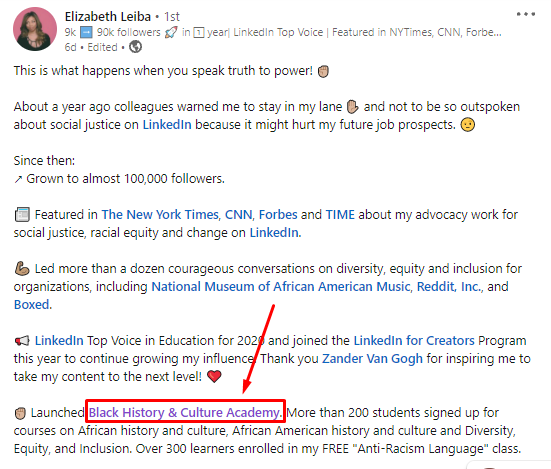
Leveraging LinkedIn Influencers
I’m not sure why, but I don’t see a lot of influencer posts on LinkedIn. Influencer marketing is huge on platforms like YouTube, Twitter, Instagram, and Facebook. So, why not LinkedIn?
Think of someone in your industry who gets a lot of meaningful engagement when they share content. If you have a new product that just launched or you’re hosting an event soon, use influencers to spread the word and tap into their audience.
Seun Odegbami, who hosts LinkedIn Local Lagos, does a great job leveraging micro-influencers for more conversions.
This post by Ameenah Aderinto promoting LinkedIn Local Lagos only got 35 reactions, but the comment section shows that people are signing up to attend.
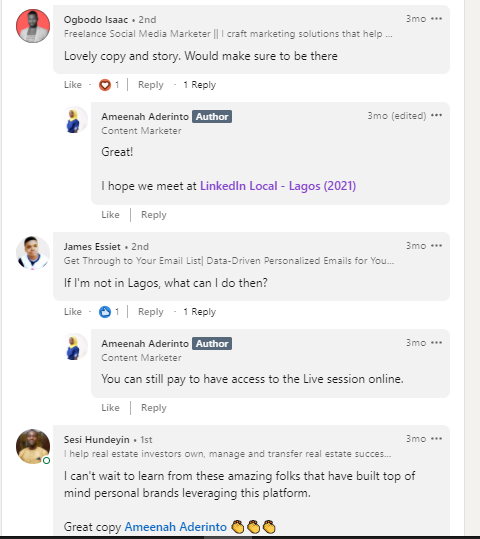
Encouraging Employees to Get Active on LinkedIn
Companies generate 30% of their engagement through employees. When employees have a LinkedIn profile and are active on LinkedIn, several things can happen:
- They list your company as their workplace, which is like an inbound link to your LinkedIn page
- They follow your company profile
- You can ask them to engage with company content to increase the reach to their audience
- When they share content on LinkedIn, connections who want to learn more about the employee, go to their profile, see they work for you, and follow your company page
Devin Reed and Udi Ledergor from Gong are great examples of employees who use their personal profiles to promote their employer. Notice how much engagement their posts receive?
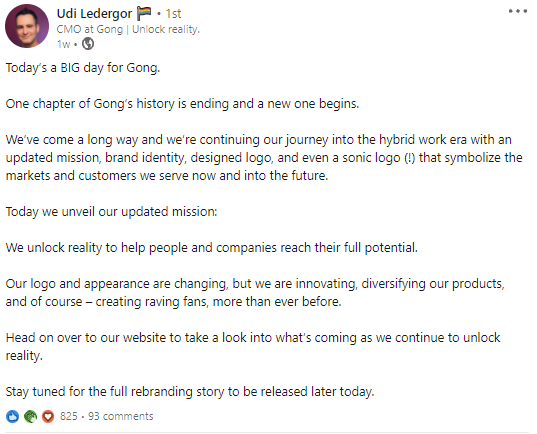
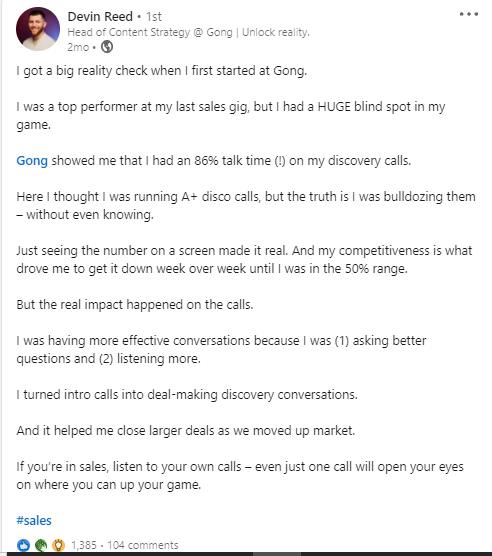
8. Use a Content Calendar to Ensure Consistency
Here’s how Alastair Banks explains consistency:
Consistency is the key. You have to turn up, share valuable content, and turn up again. There is no silver bullet for creating a winning LinkedIn marketing strategy. Those who use hacks last a while, but those who develop their personal brands over time are the ones that win.
Consistency is showing up regularly with relevant, helpful content that gives lots of value to the reader. One of the best ways to ensure consistency is to use the Semrush Social Media Poster.
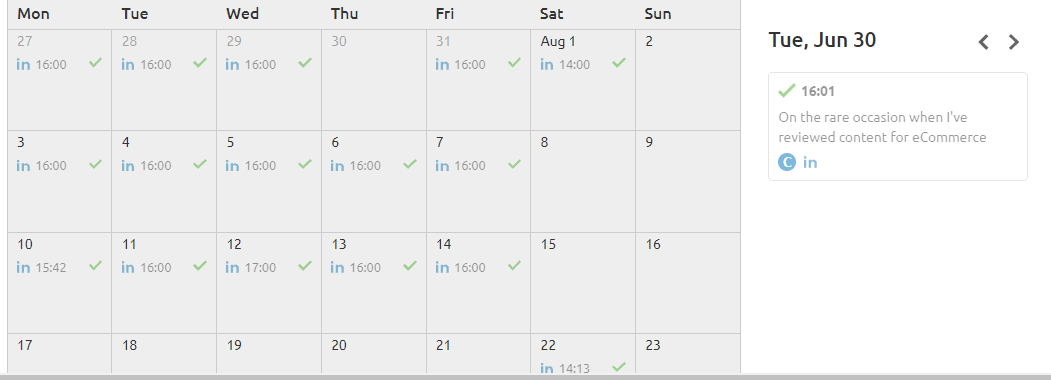
I use it to schedule content simultaneously for Facebook, LinkedIn, and Twitter (you can also use it for Instagram, Pinterest, and Google My Business). I can add media content, gifs, and even emojis to my posts.
To extract as much juice as possible, I schedule my best LinkedIn posts to repeat at intervals of five to six months because people forget quickly, and the same post will likely have as much engagement.
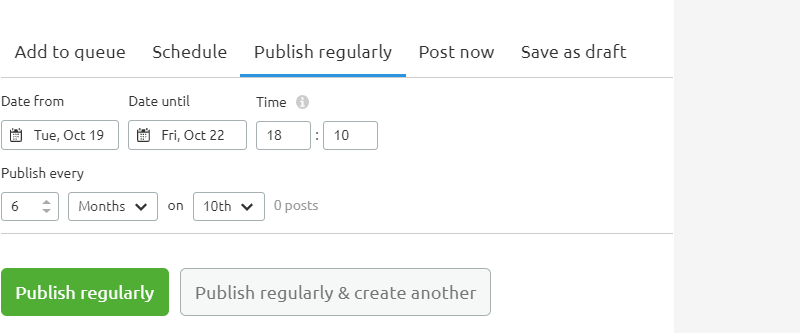
If you’re only using the Semrush Social Media toolkit for your business, the free account works fine. But if you manage social media for clients, then purchase a paid plan. Paid subscriptions allow you to connect more social profiles and monitor more accounts ( see details here).
Here’s a guide on how to configure Social Media Poster.
After you begin posting content, you can use the Social Media Tracker to see how your posts are doing. This tool allows you to monitor the overall performance of LinkedIn, Facebook, Instagram, Twitter, Pinterest, and YouTube accounts.

This tool also shows your top content by engagement, which can help you shape the strategy for future posts.

9. Create Content That Shows Your Expertise and Personality
Here’s a great tip from Ross Simmonds on the type of content that works on LinkedIn:
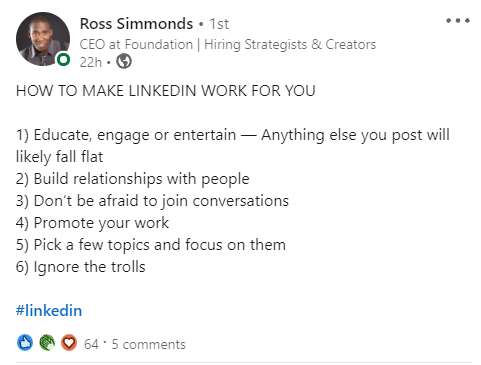
Consistency is hard. Many people drop off after they’ve gotten some traction in their business. But if you want to stand out on LinkedIn and build a sustainable lead gen machine, content creation should be at the heart of your LinkedIn marketing strategy.
Here are some tips that will work for any brand.
Repurpose Blog Posts into LinkedIn Content
Most of my LinkedIn content is inspired by my blog. I take a blog post or guest post I’ve written and turn the subheadings into digestible LinkedIn content.
For example, this post on keyword research tools was inspired by this post on how to conduct keyword research.
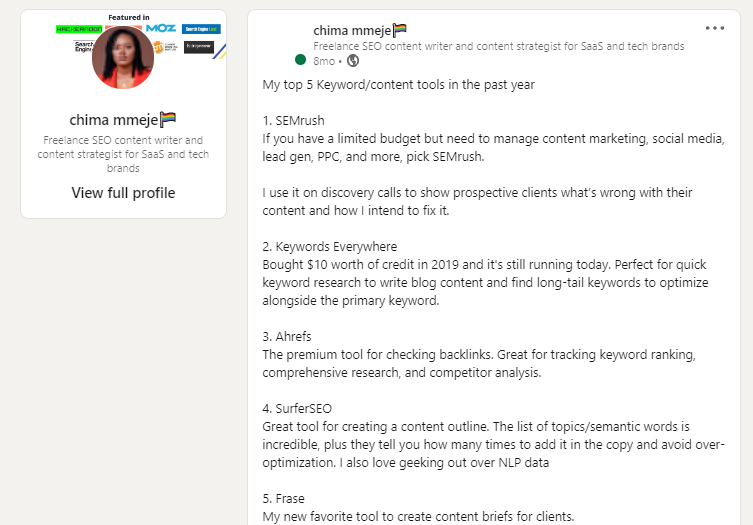
Turn Workflows into Stories
What have you been working on recently? Any new projects, client results, or exciting news you’d like to share?
I **** how Carrie Rose talks about her mission with Rise at Seven. She shares content about her latest projects, her internal process for collaboration, and everything in between.
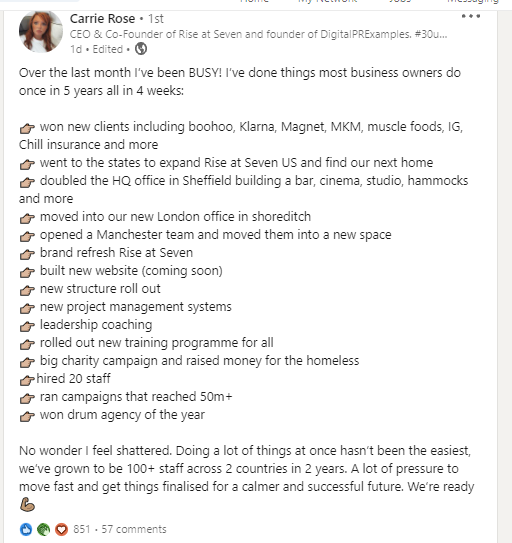
Sharing your company workflow is like bringing the public into your cycle. That level of transparency makes your connections feel like they know you. It’s an excellent strategy for Carrie, given the success her agency has enjoyed in recent years.
Share Mistakes
Everyone is so obsessed with success that we forget about the learning curve. And you know what happens during the learning curve? Mistakes.
Mistakes are good. They make you human and show that very few people get it right the first time. Sharing wrong turns on your journey humanizes your brand and makes it easy for your audience to relate with you on a personal level.
Embrace Storytelling & Humor
It’s not enough to show your expertise. You have to learn how to weave storytelling into your LinkedIn posts to engage your audience.
I remember the early days of LinkedIn when I would get five likes on a post and ten on a good day. My content was drab and lifeless. It didn’t inspire the reader to take action or comment on the post.
It all changed when I started using storytelling to explain complex concepts and make them easier to understand. For example, I used jollof rice as an analogy to describe why it’s vital for content to marinate overnight.
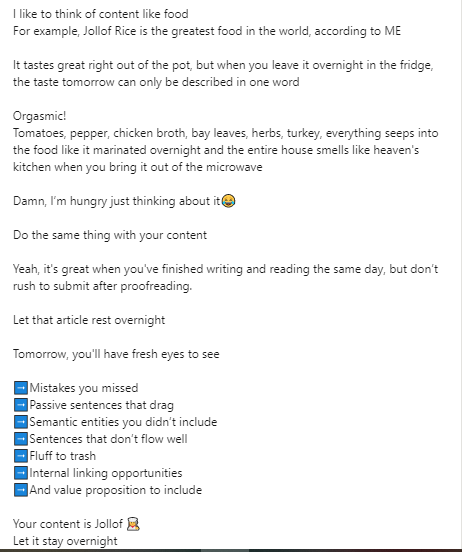
I also use storytelling to invite my connections into my personal life to see the human being behind the posts. The blend of humanity and expertise is the secret to my success on LinkedIn.
A post about not wearing pants to a Zoom meeting turned into an invitation to speak to a digital marketing class at the University of Pittsburgh.
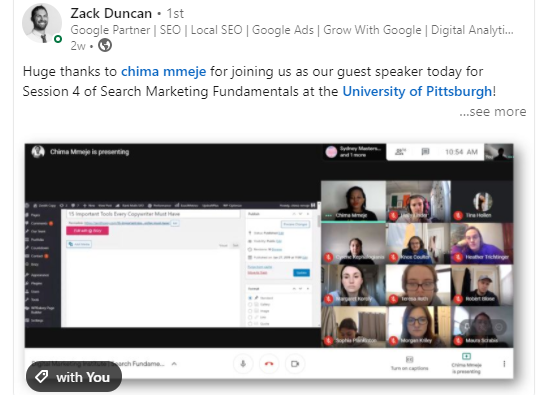
10. Show Expertise
Here’s the thing about sharing knowledge. There’s something you know that someone else doesn’t. It’s obvious to you, but not to others. Share it!
Expertise doesn’t have to be advanced knowledge about a topic. I share tips on optimizing SEO content, building topic clusters, doing keyword research, and other SEO-related topics.
Avoid the temptation to tell meaningless stories that evoke emotion but don’t lead to queries about your services. You might get a lot of engagement but zero leads.
Expertise is helpful and practical advice. It’s sharing information that your audience can implement immediately. It’s the little details in your process that make you superior to everyone else.
Above all, expertise leads to inquiries from your ideal customer who is convinced that you’re the best option for the service you deliver. This is the central goal of your LinkedIn strategy.
11. Use a Mix of Content Formats
Everyone has a different preference for consuming information. Some users like video, others like text and images. Mix up your LinkedIn content with all three formats.
LinkedIn users are 20x more likely to share video content. Videos are great for showing your process and taking your audience behind the scene. Use infographics to share statistics or highlight key information in your post. Long-form content tends to perform well on LinkedIn, so consider publishing more text-based content with a mix of multimedia thrown in for freshness.
Social media platforms don’t want you linking out. They want to keep the reader engaged with the content you’ve published for them. LinkedIn algorithms usually bury posts with links in them.
However, I’ve noticed two scenarios where links in the post perform well:
Influencer post: When an influencer shares content with links in the post, it performs well because they already have a massive following. Here’s an example from Brigette Hyacinth with a YouTube link in the post and over 1,700 reactions.
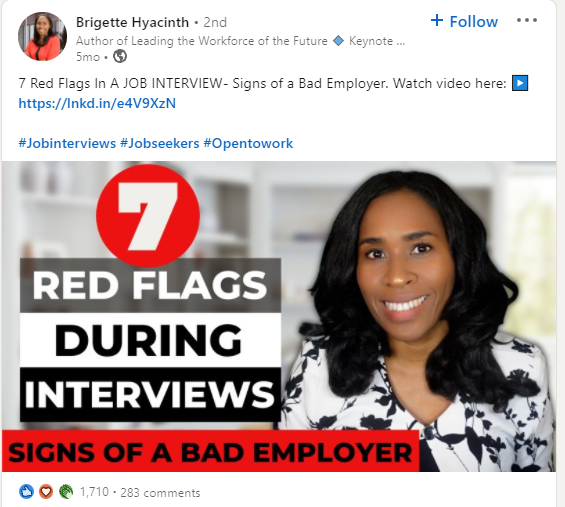
Long-form post: I’ve also noticed that many people will see the post if you add long-form content to a post with an outbound link. For example, this post has a link in the text, but it’s long-form, and nearly 7,000 people saw it.
If you don’t have a large following like Brigette, play it safe by adding the link in the comment section so your post has a greater chance of performing well.
13. Avoid the Temptation to Automate Outreach
Automated LinkedIn messages are spam. You’re sending the same message to everyone without personalization. Nobody likes it, and LinkedIn is cracking down on automation tools. So, be careful with anything that automates messages, connection requests, or profile visits.
Instead, use a template to streamline your cold messaging but leave blanks for personalization options such as connection name, problems they face, and your unique approach to solving the problem.
Track Analytics to See if Your Strategies Are Working
LinkedIn Analytics allows you to track progress, see what’s working, and identify areas of improvement.

Another remarkable feature that Semrush provides is Social Media Analytics. I can view information for LinkedIn pages such as:
Follower count by:
- Country
- Industry
- Job function
Engagement metrics:
- Likes
- Comments
- Clicks
- Shares
- Total follower count
- Average engagement rate growth
- Follower gain
- Reach
- Impressions
The LinkedIn report shows how well your audience is engaging with your content, so create more of what brings engagement and results.
Final Thoughts
The most successful people on LinkedIn give more than they take. I want you to create so much value that people look forward to seeing your content.
So, how do you market on LinkedIn? Optimize your LinkedIn profile to attract the right audience. Ask for recommendations from satisfied customers. Share practical advice to build authority. Use stories to connect with your audience and show your human side. Finally, remember that LinkedIn is human first, so don’t be afraid to show up authentically.
Source link : Semrush.com
